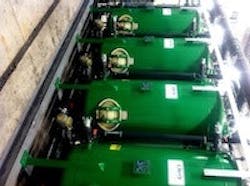Contaminant Removal Meets Community’s Water Conservation Goals
A small community where civic and business leaders embrace a "paying it forward" ethic, Scott City, Kan., places heavy emphasis on water conservation and protection of its underground water supply.
Located 62 miles from the Colorado border in southwestern Kansas, Scott City was named an All-America City in 2011 by the National Civic League.
Background
Commercial cattle feeding is the largest employer in area. With an agricultural economy, the city of 4,000 residents continuously monitors its water supply for contaminants. Elevated nitrates commonly leach through soil and loose rock, and farm communities commonly find these in their groundwater supplies.
In 2010, concentrations of nitrate in four of Scott City's five wells were found to exceed the U.S. Environmental Protection Agency’s (EPA) maximum contaminant level (MCL) of 10 parts per million (ppm), and arsenic concentrations were approaching the EPA’s 10 parts per billion (ppb) MCL. Until then, the city's only experience with operating a water treatment system was limited to state-owned, carbon-filter systems for removing petroleum.
The city quickly began looking for treatment alternatives and issued a request for proposals.
Layne Christensen Co. proposed its packed-bed, low-waste ion exchange system, which consistently achieves high filter-loading rates. The regeneration process that Layne developed and uses generates less than 0.6% waste, while other technologies usually generate 3% to 6% waste brine.
Due to drought conditions in the Midwest, water conservation is of utmost importance for Scott City, where the percentage of water loss is calculated and tracked at every step of the water cycle.
Through a competitive bidding process, Layne was awarded the contract, which called for two packed-bed, low-waste ion exchange systems: one for the city's North plant for wells 1 and 5 at 1,100 gal per minute (gpm), where the main contaminant is nitrate ranging from 15 to 25 ppm and with arsenic approaching 10 ppb; and the other for its South plant for wells 4 and 9 at 1,000 gpm, where the main contaminant has been arsenic of approximately 14 ppb and nitrates recently approaching or above the 10 ppm MCL.
Mike Todd, public works superintendent, and his staff worked closely with Layne Sales Engineer Ron Rappard and colleagues as the systems were installed.
Testing & Start-Up
Layne pilot-tested three different resins for the new ion-exchange systems and found that a nitrate analyzer could be used successfully to determine nitrate breakthrough at both plants. When the nitrates break through, the arsenic, along with sulfates, is not far behind. This is fortunate because on-line arsenic analyzers are expensive and arsenic field tests are not totally reliable.
Both systems were started up in early September 2012, and contaminant removal is better than predicted, maintaining water quality with ease and at a better percentage of water loss than expected. The waste brine at the North plant is discharged into lined lagoons, and the waste at the South plant goes to a municipal sewer leading to a wastewater lagoon.
The engineering estimate predicted that these two systems would cost $10 million, but due to Todd's hands-on crew and willingness to perform many of the tasks, the actual cost for both systems and associated infrastructure was just under $4 million.
Layne wasn’t the lowest bidder but won the contract by including a number of advantages over the competitors. Foremost was the low amount of waste generated. Plus, Layne’s system included a supply of additional parts that competitors didn’t include, which evened out cost considerations.
Todd reported that installation went smoothly, noting Layne's interface with the existing SCADA system was seamless. Layne's plans were simple and easy for the electrical contractor to follow. Training went well, too, Todd said.
“Ron could not have been a better person to work with,” Todd added.
Overseeing water, sewer, streets, parks and the airport as the city's public works superintendent, Todd also appreciates the SCADA system that allows him to monitor the operations without physically being onsite, which is important considering the many hats that he wears.
"I spend less time in our plant than I originally expected," he said.
Consistent with the city's "paying it forward" philosophy, Todd also opted for oversized treatment buildings with the expectation of future growth. Layne’s systems are prepared to expand with electrical and plumbing ready for the task.
Ron Rappard is a water treatment specialist for Layne. Rappard can be reached at [email protected]. Lisa Culbert is marketing manager for Layne. Culbert can be reached at [email protected]. Matt Bokor is a consultant for Layne. Bokor can be reached at [email protected].
